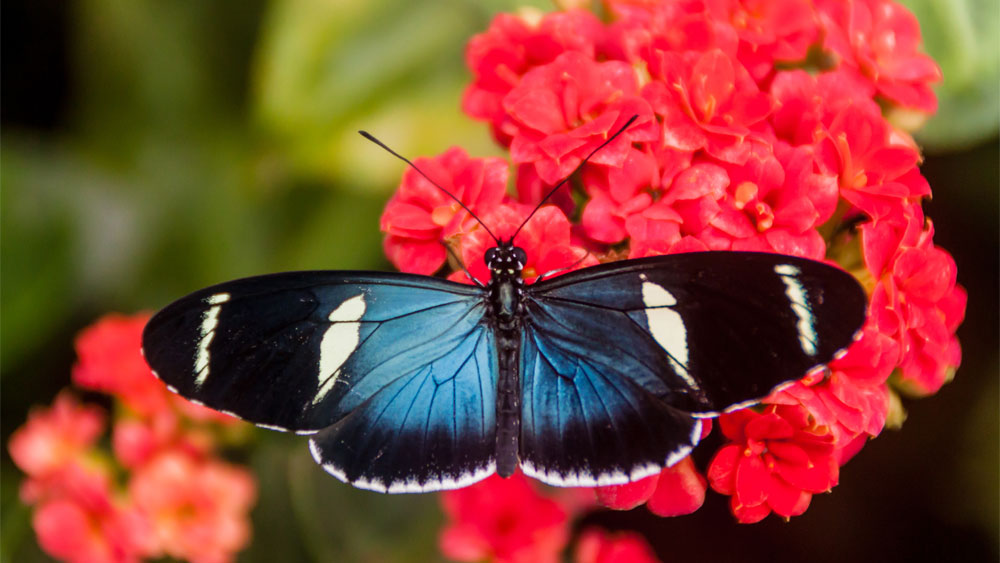Gone are the days when many people (biologists included) saw insects as simple creatures that did little more than reproduce, eat, and grow—with some migrating. But as the decades of research passed, it was obvious that insects were hardly simple and uncomplicated creatures. They’re far from it.1,2
Now entomologists are finding—for the first time—that butterflies in their erratic flight are actually undergoing complex spatial learning. The amazing cognitive ability of these insects is in addition to their design and capability to migrate 3,000+ miles.3 This spatial learning of the lepidoptera (moths and butterflies) had not been investigated until now.
In neuroscience, spatial learning (and memory) is the process by which a creature acquires a mental representation of its external space. This includes how the information is acquired, organized, stored, and used.
Scientists in England’s University of Bristol have uncovered the first evidence of spatial learning in any butterfly or moth species.4
Spatial learning is known in insects, but much of the research has focused on ant and bee species which live socially in a communal nest. This study provides the first direct evidence of spatial learning in butterflies or moths, and suggests that complex learning skills, such as the use of spatial information, may be more common in insects than previously thought.5
Antoine Couto and fellow researchers report in Nature magazine,
The genus Heliconius [butterfly], which exhibits a unique dietary innovation, pollen-feeding, and [advanced] foraging behaviors reliant on spatial memory, shows the most extreme enlargement [the central brain structures pivotal for insect learning and memory, called the mushroom bodies]. This expansion is primarily associated with increased visual processing areas and coincides with increased precision of visual processing, and enhanced long term memory.6
In other words, these butterflies are designed with a unique foraging behaviour—the ability to feed on pollen. What is amazing is that Heliconius, evidently, have acquired a knowledge of where reliable pollen sources are present via learned foraging routes called ‘traplines.' The butterflies repeatedly return to these food sources in much the same way as some bumblebees and orchid bees do.
Using Heliconius, the scientists conducted spatial learning experiments “over three spatial scales representing ecologically-relevant behaviours.”4
The results of these experiments gave “the first direct evidence of spatial learning in a butterfly” and their ability to “memorize the spatial location of food sources.”4
Dr. Stephen Montgomery of the University of Bristol's School of Biological Sciences stated, "It's fascinating to learn about the complex behaviours that even familiar animals like butterflies express as part of their natural ecologies. These species are extracting and processing diverse information from their environment and using them to perform complex tasks—all with brains a couple of millimetres wide."5
The authors of the Nature article appeal to evolutionary events that occurred in the unobserved past and, therefore, must be taken by faith: “Throughout animal evolution, the nervous system has acquired new features, built on previously existing functions, which have allowed animals to evolve new ways [emphasis added] of perceiving and interacting with their environment.”6 How can such a statement be scientifically validated? After all, “the origins of neural systems remain unresolved[,]”7 and, “there is no evolutionary record of nervous systems..."8
Once again, detailed scientific research has authenticated what our Lord has done in these amazing insects. Chance, time, and cryptic natural processes would never produce “the complex behaviours that even familiar animals like butterflies express.”5 The creation scientist gives glory not to "Nature," but to Christ, the true Creator. We can learn from the creatures He has created as we investigate His living creation.
References
- Sherwin, F. and J. Tomkins. Fruit Fly Smell via Incredible Nanopore System. Creation Science Update. Posted on ICR.org May 7, 2019, accessed August 8, 2023.
- Thomas, B. Cicadas Make Great Mathematicians. Creation Science Update. Posted on ICR.org May 22, 2013, accessed August 7, 2023.
- Thomas, B. Monarch Butterfly Antenna: A Hi-tech Tiny Toolkit. Creation Science Update. Posted on ICR.org October 9, 2009, accessed August 7, 2023.
- Science Writer. Butterflies can remember where things are over sizeable spaces. ScienceDaily. Posted on sciencedaily.com August 7, 2023, accessed August 8, 2023.
- Science Writer. Butterflies can remember where things are over sizeable spaces, study finds. University of Bristol. Posted on bristol.ac.uk August 7, 2023, accessed August 7, 2023.
- Couto, A. et al. Rapid expansion and visual specialisation of learning and memory centres in the brains of Heliconiini butterflies. Nature. Posted on nature.com July 7, 2023, accessed August 8, 2023.
- Moroz, L. et al. 2014. Ctenophore genome and the evolutionary origins of neural systems. Nature. 510 (7503): 109-14.
- Science Writer. Breakthrough model reveals evolution of ancient nervous systems through seashell colors. Phys.org. Posted on phys.org January 12, 2012, accessed August 8, 2023.
* Dr. Sherwin is science news writer at the Institute for Creation Research. He earned an M.A. in zoology from the University of Northern Colorado and received an Honorary Doctorate of Science from Pensacola Christian College.





















